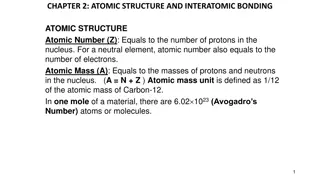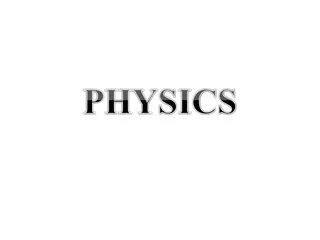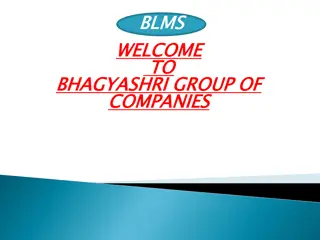Laboratory for Teaching Laser and Atomic Physics at AAPT Conference
Explore the laboratory curriculum for teaching laser and atomic physics developed by Joseph E. Wiest at West Virginia Wesleyan College. The course encompasses electro-optics, quantum models, optics concepts, laser operations, and experimental objectives. Discover the history and applications of various lasers, such as the Ruby Laser, Helium-Neon Lasers, and more advanced setups like the AlGaAs Tunable Diode Laser. Dive into practical experiments with lasers and delve into the physics principles behind them.
Download Presentation

Please find below an Image/Link to download the presentation.
The content on the website is provided AS IS for your information and personal use only. It may not be sold, licensed, or shared on other websites without obtaining consent from the author.If you encounter any issues during the download, it is possible that the publisher has removed the file from their server.
You are allowed to download the files provided on this website for personal or commercial use, subject to the condition that they are used lawfully. All files are the property of their respective owners.
The content on the website is provided AS IS for your information and personal use only. It may not be sold, licensed, or shared on other websites without obtaining consent from the author.
E N D
Presentation Transcript
A Laboratory to Teach Laser and Atomic Physics Joseph E. Wiest West Virginia Wesleyan College AAPT Conference Cincinnati 2017
Course Description Name: Electro-Optics (Laser Physics) Number: PHYS 305L Level: Junior Time: Three hours per week Text: A Laser Laboratory Guidebook , Joseph E. Wiest Pre-requisite: PHYS 210 Light and Atomic Physics When offered: Each semester Enrollment: 12 14 per semester Founding date: About 1985
Pertinent Physics Principles to Be Taught Quantum oscillator model Quantum atomic model Nuclear shell model Doublet and hyperfine structure of the atom Physical optics concepts Operating principles of gas, solid state, and dye lasers Molecular structure Molecular dynamics Bethe-Weizsacker mass equation/nuclear stability
Experimental Objectives History, development, and applications of the laser Doublet and hyperfine structure of the alkali metal elements The acousto-optic effect Bond strength of the linear molecule The pumped tunable dye laser Raman effect in polymers Frequency doubling in crystals Stable isotopes of elements
The Temperature-Tunable Diode Laser Cathode Anode
Calibration of the AlGaAs Tunable Laser 781.5 781 780.5 Wavelength (nm) 780 y = 0.0361x + 778.89 779.5 779 Laser Current (mA) 778.5 0 10 20 30 40 50 60 70 80
Rubidium 780 nm Line Data 1.6 Rb-85 1.4 1.2 1 Intensity (mV) Rb-85 0.8 Rb-87 Rb-87 0.6 0.4 0.2 0 46.5 47 47.5 48 48.5 49 49.5 50 50.5 51 51.5 Laser Injection Current (mA)
Rubidium 795 nm Line Data 1.55 Intensity of Signal (mV) 794.965 nm 794.959 nm 1.5 1.45 1.4 1.35 1.3 1.25 65 65.5 66 Injection Current (mA) 66.5 67 67.5
Hyperfine Splitting of the 852 nm Line in Cs 250 200 852.361 nm 852.338 nm 150 Intensity (mV) 100 50 0 84 86 88 90 92 94 96 98 Piezo Voltage (V)
Hyperfine Splitting of the 894 nm Line in Cs 60 893.744 nm 50 893.722 nm Intensity (mV) 40 30 20 10 0 48 48.5 49 49.5 50 50.5 51 51.5 Injection Current (mA)
Nuclear Energy Levels Maria Goeppert Mayer for 1H , 7Li , 23Na , 39K , 85Rb , 133Cs 8 Cs + 22 above 5 Cs 8 Rb 10 Cs 10 Cs 2 Rb 2 Cs 2 Cs 6 Rb 6 Cs 5 Rb 6Cs 1f5/2 4 Rb 4 Cs 4 Rb 4Cs 2P3/2 8 Rb 8 Cs 8 Rb 8Cs 1f/7/2 4 K 4 Rb 4 Cs 3 K 4 Rb 4 Cs 1d3/2 2K 2 Rb 2 Cs 2 K 2 Rb 2 Cs 2S1/2 4 Na 6 K 6 Rb 6 Cs 3 Na 6 K 6 Rb 6 Cs 1d5/2 1 Li 2 Na 2 Rb 2 Cs 2 Na 2 K 2 Rb 2 Cs 1P1/2 4 Li 4 Na 4 K 4 Rb 4 Cs 1 Li 4 Na 4 K 4 Rb 4 Cs 1P3/2 2 Li 2 Na 2 K 2 Rb 2 Cs 1 H 2 Li 2 Na 2 K 2 Rb 2 Cs 1S1/2 Neutrons Protons 1g7/2 1g9/2 2P1/2
Rubidium - 85 Doublet and Hyperfine Levels Atomic energy state of J = 1/2 , Nuclear state = 5/2 : F = Net atomic state = I ( Nuclear state ) + - J ( Atomic state ) F = = 5/2 +- 1/2 = 2 , 3 F = 4 3 Atomic energy state of J = 3/2 : 5P3/22 5P1/2 3 1 F = 5/2 +- 3/2 = 1 , 2 , 3 , 4 780 nm 2 795 nm 3 Transition rules: 5S1/2 L = +- 1 F = 0 , +- 1 2 2 3
Hyperfine Energy Level Splitting (Steck) The Hamiltonian Hhfs = AhfsI J + Bhfs (3(I J)2+3/2(I J)-I(I+1)J(J+1)) 2I(2I-1)J(2J-1) Ahfs = Magnetic dipole constant Bhfs = Electric quadrupole constant (J>1/2)
Calculating Hyperfine Energy Splitting (Steck) Ehfs = (1 /2) AhfsK + Bhfs{[(3/ 2)[K(K + 1) 2I(I + 1)J(J + 1)]/[ 2I(2I 1)2J(2J 1)]} where K = F(F + 1) I(I + 1) J(J + 1)
Hyperfine Splitting Measurements Rubidium : Measurement (nm) Accepted Value (nm) % Diff (Rb-85) 780.652 780.238 .0531 780.712 780.244 .0600 794.959 794.975 .00201 794.965 794.982 .00214 Cesium: 852.338 852.335 .000352 (Cs-133) 852.361 852.357 .000469 893.722 894.579 .0958 893.744 894.603 .0960
Spectrum of Iodine Molecule Excited by Frequency-Doubled Nd:YAG Laser
The Birge Sponer Plot Birge - Sponer Plot for Iodine 2.5 y = -0.0202x + 2.1977 2 1.5 E x104 (m-1) 1 0.5 0 0 2 4 6 8 10 12 Level Number ( +1)
Calculations from the Data; Harmonic Oscillator Model K = m ( 2 c 0)2 = 127x1.6605x10-27 /2 x (2 x 2.9979x108 x 2.198x104)2 = 180.7 N/m (Our result) K = 172.1 N/m(Bayram And Freamat)
Raman Scattering (Nylon) Rayleigh Peak 25 20 Intensiity (nA) 15 10 5 0 3248 3250 3252 3254 Wavelength( ) 3256 3258 3260 3262
Raman Scattering (Nylon) Stokes Peak 0.45 0.4 0.35 Intensity (nA) 0.3 0.25 0.2 0.15 0.1 0.05 0 3458 3459 3460 3461 Wavelength( ) 3462 3463 3464 3465
Raman Scattering (Nylon) Anti-Stokes Peak Anti-Stokes Peak 0.35 0.3 Intensity (nA) 0.25 0.2 0.15 0.1 0.05 0 3050 3051 3052 3053 Wavelength( ) 3054 3055 3056 3057
The Stable Isotopes of Krypton Kr-82 0.7 Height of Jump [mV] 0.6 Kr-86 0.5 0.4 0.3 0.2 0.1 0 61.7 61.8 61.9 62.2 62.5 Injection Current [mA]
Conclusions Course reviews and reinforces concepts of previous year classes in light, atomic, and nuclear physics. Students are prepared to do funded summer research work on our campus or other involving laser/atomic physics. Graduates report experience from course has facilitated good graduate research assignments. Graduates report good use of concepts and techniques of course in both physics and engineering graduate study. Hands-on experience and research techniques encountered in course have provided excellent preparation for the year of senior research.
Acknowledgements NASA WV Space Grant Consortium West Virginia Wesleyan College Aaron Weaver, (Wesleyan 2015, now grad Physics at WVU) Mackenzie Robatin and Gabrielle Cox, Summer Research 2017 Students in the Electro-Optics Classes of 1993 to 2017 SURE Grant Program Robert Grose for machining; Tracey Delaney for computer and technical help Dr. G.S. Hurst, Oak Ridge National Laboratory
References 1. S.B.Bayram and M.V.Freamat, Simple Laser-Induced Fluorescence Setup to Explore Molecular Spectroscopy , Compadre.Org /advlabs/bfy/files/W31, 1-8 (2012). 2. Livesey, Derek, Atomic and Nuclear Physics (Ginn and Blaisdell, Toronto, 1966). 3. Serway, Moses, Moyer, Modern Physics (Thomson-Brooks/Cole, Belmont, CA, 2005). 4. Steck, Daniel, Dept. of Physics, Univ. of Oregon, Rubidium 85 D Line Data, 2013. 5. Steck, Daniel, Los Alamos National Laboratory, Cesium 133 D Line Data, 2003. 6. Derek Eastham, Atomic Physics of Lasers (Taylor and Francis, 1986). 7. H.Haken and H.C. Wolf, Atomic and Quantum Physics (Springer-Verlag, 1984). 8. C.J. Foot, Atomic Physics (Oxford Press, 2005). 9. David Van Baak, Physics Dept., Calvin College, 1993.























